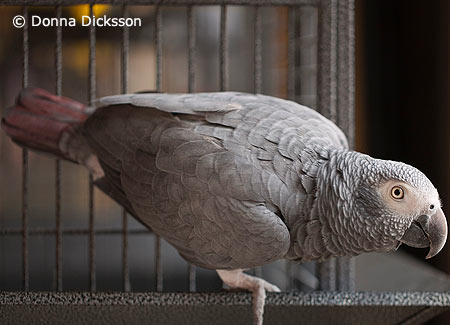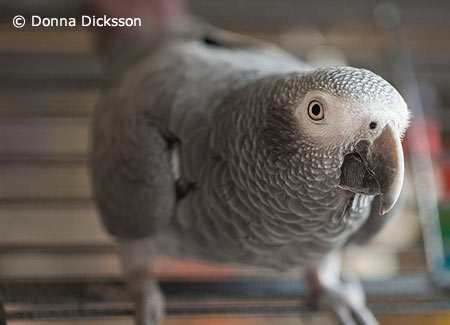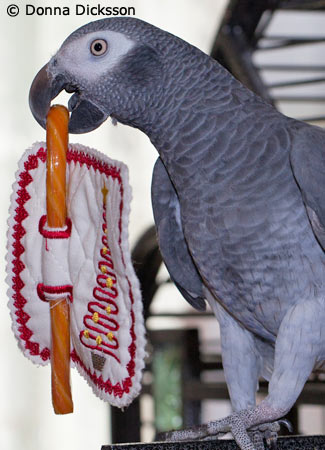[bars]
Common Names: Timneh African Grey, Red Tails, TAG
Scientific Name: Psittacus erithacus timneh
Origin: Guinea-Bissau, Sierra Leone, Southern Mali,
Relative Size: 11 inches
Weight: 350 grams
Average Lifespan: 30-50 years
Egg Clutch: 3-5 eggs, typical clutch is 3 eggs
Incubation: 28 days
Talking Ability: Superior

The Timneh African Grey looks very similar to the Congo African Grey. Many people who are new to parrots find it difficult to differentiate between the two species as they look very similar. The more obvious difference between the two parrots is that Timneh Greys are smaller and darker in appearance and also have a smaller black beak with a beige patch located on the upper portion.
Like their larger cousins the Congo African Grey, these parrots also have white eye patches that surround their eyes. Their eye pupils are yellow and black giving these birds a striking appearance. Their wings lack color but showcase many shades of charcoal gray and black. When in flight, lighter shades of gray and white can be seen giving these birds an angelic look. Their feet are large and bulky compared to their bodies and are always tucked back underneath their bodies when in flight.
These birds are not sexually dimorphic. This simply means the males and females cannot visually be differentiated. If an owner or breeder wishes to know the sex of their parrot, the best way is through DNA testing. This is achieved without surgery as only a few feathers are needed from the bird to determine the bird’s gender.
[ads]
Unlike most parrots, these pigeon-sized birds do not come in many colors. In fact, some Timnehs might have an occasional red feather on their chest area or on their thigh. Although not as colorful as other parrots, these birds are still sold at a normal price. Not much effort has been placed into developing mutations for these particular birds; however, this could be due to the fact that most sought after are their larger cousins.
Timneh African Greys in the Wild
Timneh African Greys are originally from the rain forests of Western Africa. These birds thrive in large colonies and are very shy creatures. Unlike South American parrots, these birds do not like to flock with other bird species. Instead, they spend their time mainly with other African Greys foraging for food and eating tender roots and shoots. They are most often spotted at waterholes consuming clay. It is believed that by eating clay, it removes any toxins ingested while in their natural habitat and also provides the birds with minerals.
Because these parrots are popular, these birds are trapped and sold for the pet trade. A trapper who wishes to capture a Timneh African Grey will usually place glue onto twigs and wait for the birds to land. Another method of trapping these birds consists of using nets. These nets are strategically placed to capture the birds as they forage for food along the ground. Once the birds are trapped, they are put into wooden crates and shipped around the world. Most trappers do not put too much effort into ensuring the parrots are properly cared for as they are only seen as a product. For this reason, many die or are badly injured during transportation to other localities.
When breeding in the wild, these birds will pair off and look for a nesting site that is hidden from obvious predators. Usually old trees are preferred as the wood can easily be gnawed by the female and the nest can be constructed to her liking. The female will incubate the eggs while the male stands guard. Both the male and female will feed the babies until the baby birds leave the nest and are weaned. It is believed the juvenile birds will remain with their parents for at least a year before they are left to fend for themselves.
Timneh African Greys in Captivity
African Greys have been kept in captivity for hundreds of years. Though we will never know which was more popular between the two Grey species historically, one thing remains apparent, these birds have been documented all the way back to Alexander the Great and appear to have been as popular then as they are today. In fact, these birds were kept by many prominent historical figures such as King Henry VIII, Queen Victoria, and Marie Antoinette.
In the United States, these parrots are abundant and easy to find. If a person is looking to buy a Timneh African Grey, they can begin by searching within their local bird clubs, bird conventions/shows, or through local classified newspaper ads. These birds are not as expensive as their larger cousin and can be readily purchased as handfed parrots.
Timneh African Greys as Pets
Timneh African Greys are wonderful parrots to own. They are smart pets that are often described as being unique in terms of companionship. They form strong bonds with their owners and thrive for attention if handfed and well socialized. These birds do not tolerate being left alone for long periods of time and will become mentally challenged if ignored. If an owner wishes to purchase a Timneh African Grey, they should be prepared to incorporate the bird into their daily lives. If an owner only minimally interacts with their bird, this could be extremely detrimental to the parrot as they need a lot of attention.
Like the Congo African Grey, these birds are smart and are deemed as supreme talking parrots. They seem to say the right things at the right time and many owners claim their birds know what they say. Some birds start talking around five months but most will start around eight months. Just before the bird actually talks, they go through a babbling stage. During this time, the bird owner should be encouraging the bird to talk and the owner should praise the bird for whistles, anything that sounds like talking, and/or gibberish.
Timneh African Greys begin talking sooner than the Congo African Grey. Most will pick up a few words between five and six months of age. Over a year’s time, a parrot’s vocabulary can grow to hundreds of words.
It is important the owner not purchase a bird based solely on the parrot’s talking possibilities because not all African Greys will learn to talk. Some African Greys just never learn to mimic humans and this often leads to disappointment by the owner. When this happens, the bird is usually ignored. The bird should be picked for its personality and cherished as a pet. If the bird happens to talk, then this should be viewed as an extra perk.
Timneh African Grey parrots can be loud but not as loud as their cousins the Conures or the Amazons. Some owners can even get away with owning a Timneh African Grey in an apartment setting. These birds should be expected to vocalize during the early morning, noon, and before sunset.
Many owners are often misled as baby Timneh African Greys are quiet at first. As the bird matures it becomes much more vocal and many owners can find this to be irritating. These contact calls are natural to the bird but can be minimized. At times, some birds go on to become excessive screamers and it’s up to the owner to work towards decreasing this type of vocalization.
Handling a Timneh African Grey

In general these birds do not enjoy heavy petting and are very similar to Asiatic parrots. They would much rather interact with their owners only by being carried on a finger or a shoulder without too much touching. Although it is generally thought that these types of birds don’t enjoy much petting, there are some birds that have been well socialized and do enjoy human contact. In this instance, it’s good to pet and touch the parrot as they like this type of affection. It is important the owner understand every bird is different and has its own personality—some are more affectionate than others. The best time these birds enjoy extensive petting is usually before bedtime or early morning.
Feather Picking
It is a well-known fact that Congo African Greys are prone to picking their feathers if neglected. Timneh African Greys, on the other hand, seem to be much more resilient in this regard and many owners almost never have to deal with this problem as these birds can be a bit more independent.
Though we will never know why these birds do not pick their feathers as readily as their larger cousins, there is one major theory as to why the Timneh is less prone to this problem. The major theory is based on the notion that Timnehs are required to be independent sooner than their Congo cousins. For this reason, they are better suited to accept change and are perfectly fine being much more independent. It is believed Congo Grey parents will remain with their offspring for at least a year, while the Timneh remains with their parents for only about six months before being independent.
If a Timneh African grey should pick its feathers it needs to be seen by a veterinarian. An avian veterinarian will do extensive blood work and rule out any bacterial infections, metal poisoning, or parasitic infections. If the bird returns with a clean bill of health, an avian behavioral consultant should be called to help remedy the problem if the problem persists.
Breeding Timneh African Greys
Timneh African Greys are not too difficult to breed. Most will breed readily if they are given the proper amount of privacy and time. These birds tend to nest during the winter and prefer to nest when it’s cooler. Probably the only difficult part about breeding Timneh African Greys is finding a pair that is compatible. Most Timnehs are sexually mature around four years of age and this would be a great time to introduce a pair for breeding. The best breeders are those parrots who have been raised by their parents or Timnehs that are not too tame.
Some African grey breeders will allow their parrots to remain in large flights until they have paired. Once they have bonded, the breeders will separate them into breeding compartments as this increases their chances for successful breeding. Many Timneh African Greys will produce two clutches of babies per year if given the chance.
A Timneh African Grey nesting cage should be suspended from the ground as this provides added security. The cage should be about 3 feet wide, 4 feet in height, and at least 4 feet in length. A stable perch should be used as this ensures a successful mating encounter. Timneh African Greys prefer deep nests. For this reason, a boot shaped nesting box should be used as the female will most likely nest as far she can inside the box. Wood shaving should be placed on the bottom for padding as the female will not add any nesting material to her nest.
It is important the owner do not disturb the birds as Timneh African Greys will abandon their nests if they feel threatened in any way. A good sign the female has laid eggs is when she remains inside her box throughout the day and only emerges to feed or to go to the bathroom. When this behavior is observed, the owner can expect the eggs to hatch within 28 days.
A typical clutch of eggs is three; however, some female African Greys may produce up to five white eggs. The female will usually start sitting once the second egg has been laid.
Once the food consumption starts to increase this is usually a great indicator the babies have hatched. The owner should then peek inside the box when the mother leaves the nest to feed and such. Most owners will keep the babies with their parents for at least 15 to 20 days before the babies are removed for hand feeding. All the babies need to be removed at the same time as the mother will abandon her nest if the babies are selectively removed.
Once the babies have been removed from their mother and the hand feeding has begun, this process can expect to take about three months. The babies will need to be fed continually until they are weaned and have learned to fly. The person hand feeding will also need to put a great deal of effort into socializing the parrot to ensure that the bird will make a wonderful pet once sent to another owner.
Selecting a Cage for your Timneh African Grey
Timneh African Greys are moderately sized compared to most parrots, but they do require larger cages. These parrots exert a great deal of energy when playing, eating, preening, and bathing. If the right cage is selected from the beginning it might be able to last the parrot throughout its life.
The cage should be as large as the owner can afford and should not be smaller than 3 feet in width, 4 feet in length, and 5 feet in height. This seems to be adequate and provides enough room to house the parrot without making it feeling too confined.
A great cage is one that has been powder coated and has a smooth surface finish. This makes cleaning the cage a simple task. These parrots are quite messy and a wet cloth is all that is needed to effectively remove food from the bars and bowls.
The bars of the cage should be sturdy and not be spaced too far apart as the parrot can easily get its head caught between them. Most pet shops will have their cages shelved according to the size made for the parrot. If the owner feels doubtful, a pet shop owner will be able to assist them and determine if the cage is sufficient for their Timneh.
The bottom of the cage needs to have a grill installed. This grill is important because the bird will be separated from its droppings, spilt food, or soiled paper. Obtaining a cage with a slide-out tray should be a feature of the cage as this makes for easy removal of unwanted material that has dropped and makes for easy daily cleaning.
The cage needs perches made of hardwood, ceramic bowls, and sturdy toys. All these items need to be suspended inside the cage. It is important toys are never placed above eating stations due to the parrots droppings.
Feeding a Timneh African Grey
 Feeding your African grey is not difficult. These birds pretty much eat anything we give them so it’s important to understand what is not to be given to a bird as it can be poisonous and detrimental to the parrot. The foods that should never be given are avocado, chocolate, large quantities of onions, or alcoholic beverages.
Feeding your African grey is not difficult. These birds pretty much eat anything we give them so it’s important to understand what is not to be given to a bird as it can be poisonous and detrimental to the parrot. The foods that should never be given are avocado, chocolate, large quantities of onions, or alcoholic beverages.
Foods that are healthy and should be incorporated into the bird’s diet are leafy greens such as spinach, kale, dandelion leaves, or mustard greens. Other healthy vegetables that are nutritious are broccoli, cabbage, or cauliflower.
Beans and legumes are perfect although they should never be given in raw form to the parrots. These need to boil until cooked and can be given with pellets or mixed into a salad.
Not only are vegetables enjoyed by these parrots, but fruits are also a treat. The owner can make fruit kabobs with mango, papaya, kiwi, oranges, lemons, or apples. It is important all uneaten fruit be removed on a daily basis to be sure it does not spoil or attract ants to the cage.
Protein should be given sparingly. These birds enjoy cooked chicken, turkey, beef, or pork. Some Timnehs will hold a chicken drumstick with one hand and eat the flesh from the bone then chew the bone for the marrow.
Because these birds enjoy foraging for food within their cage, owners should hide the food throughout the cage as this gives the bird something to do and keeps them entertained.
If properly fed, a typical Timneh Grey can live to the rightful age of around 50. Most will live well into their 30s.
[ads]
